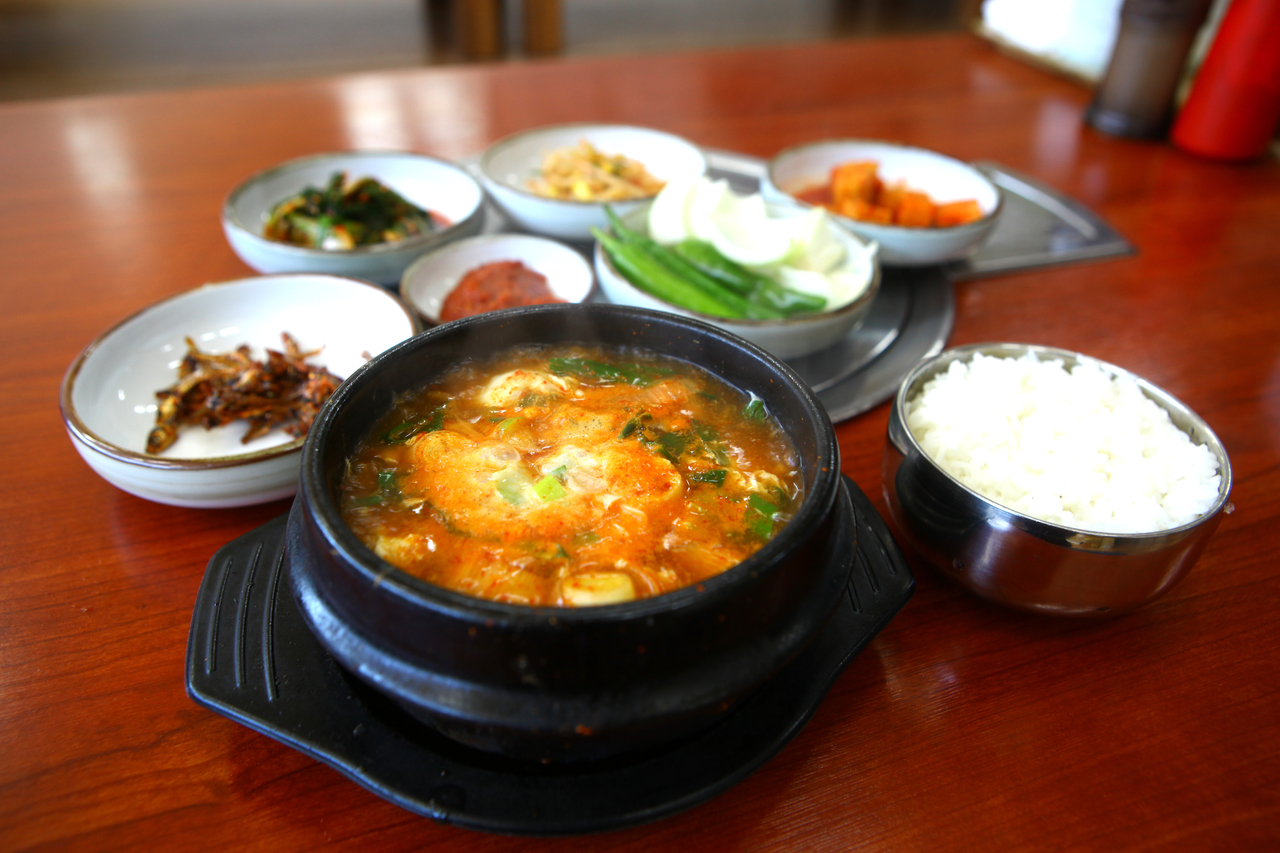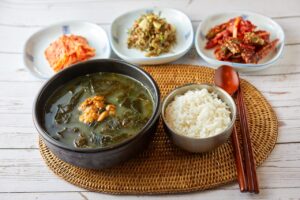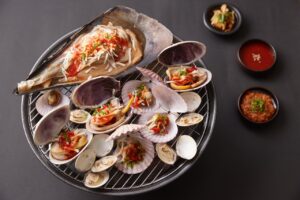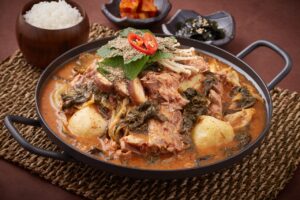
Soon Tofu Jjigae ⓒ한국관광공사 사진갤러리-이범수
History of Tofu
The history is long and can be traced back to ancient China. Here is an overview of the historical development of tofu:
Origins in China: Tofu, or bean curd, is believed to have originated in China over 2,000 years ago. The exact date of its invention is not well-documented, but it is thought to have been discovered during the Western Han Dynasty (206 BC to 9 AD) or possibly even earlier. One legend attributes its creation to Prince Liu An, a Han Dynasty royal.
Spread to Other Asian Countries: Making and consumption gradually spread to other East Asian countries, including Japan, Korea, and Vietnam. Each of these cultures developed their own variations of tofu and incorporated it into their cuisines.
Buddhist Monasteries: The one gained popularity among Buddhist monks and vegetarians in China and later in other Asian countries due to its high protein content and suitability for meatless diets. Buddhist monasteries played a significant role in both popularizing it and refining making techniques.
Ming and Qing Dynasties: During the Ming (1368-1644) and Qing (1644-1912) Dynasties in China, tofu production and consumption continued to expand, and a variety of tofu products were developed.
Introduction to the West: It was introduced to the Western world in the early 20th century, primarily through Chinese and Japanese immigrants. Initially, it was primarily consumed by Asian communities in the West.
Popularity in the West: It started gaining popularity in the West during the mid-20th century, especially during the rise of the vegetarian and health food movements. The 1960s and 1970s saw an increase in interest in tofu as a protein source in vegetarian and vegan diets.
Industrialization and Commercialization: With the growing demand for tofu in the West, tofu production became industrialized, and it became readily available in supermarkets and health food stores.
Global Acceptance: Tofu has now gained global acceptance and is widely consumed in various cuisines and dietary preferences. It is valued not only for its nutritional content but also for its versatility as an ingredient that can be used in a wide range of dishes.
Today, tofu is enjoyed by people around the world and continues to be a staple in Asian cuisines. Its long history and adaptability have made it a popular and enduring food product.
How to make it?
Making it from scratch at home can be a rewarding process, but it requires some time and patience. Here’s a simplified guide to making homemade one. Keep in mind that this is a basic recipe, and there are variations and techniques to explore as you become more experienced.
Ingredients:
- Dried soybeans (1 cup)
- Water (4 cups for soaking, plus additional for blending)
- Coagulant (e.g., magnesium chloride, calcium sulfate, or Epsom salt)
- Nigari (a common coagulant option, available in health food stores) or lemon juice can be used as an alternative
Equipment:
- Blender
- Large pot
- Cheesecloth or a tofu mold
- Heavy weight (such as a can or a tofu press)
Instructions:
- Soak the Soybeans:
- Rinse the dried soybeans and soak them in 4 cups of water for at least 8 hours or overnight. This will soften the beans.
- Make Soy Milk:
- Drain and rinse the soaked soybeans.
- Blend the soaked soybeans with 4 cups of water until you have a smooth, thick mixture.
- Strain the Soy Milk:
- Place a large pot on the stove and line it with cheesecloth or a clean cloth.
- Pour the blended mixture through the cloth to strain out the soy milk. Squeeze the cloth to extract as much liquid as possible. The liquid you obtain is soy milk.
- Heat the Soy Milk:
- Heat the soy milk in the pot over medium heat, stirring constantly to prevent sticking or burning. Heat it until it almost comes to a boil (around 180-185°C or 82-85°F). Remove it from the heat once it’s hot but not boiling.
- Add Coagulant:
- Dissolve your chosen coagulant (e.g., nigari) in a small amount of warm water.
- Slowly add the dissolved coagulant to the hot soy milk while gently stirring. The soy milk will begin to curdle.
- Curds and Whey:
- Allow the curds to form for about 15-20 minutes. You’ll see solid curds and a greenish liquid (whey) separating.
- Strain and Mold:
- Line a tofu mold or a small container with cheesecloth.
- Carefully ladle the curds into the mold.
- Press :
- Fold the cheesecloth over the tofu, place a weight (such as a can) on top, and let it press for 15-30 minutes. The longer you press, the firmer the tofu will be.
- Unmold and Store:
- Gently remove that from the mold, unwrap it, and store it in water in an airtight container in the refrigerator. Change the water daily to keep it fresh.
Homemade one may have a slightly different texture and flavor compared to store-bought varieties, but it can be quite rewarding to make your own. Experiment with different coagulants and pressing times to achieve it consistency you prefer.

1. Soon Tofu Jjigae
Soon Tofu, also known as Sundubu or Soft Tofu Stew, is a popular Korean dish known for its spicy and flavorful broth and its use of soft or silken tofu as a key ingredient. The dish typically includes a variety of other ingredients such as vegetables, mushrooms, and protein sources, which can vary depending on personal preferences and regional variations. Soon Tofu is known for its comforting, warming, and spicy qualities.
Here are the basic components of a typical Soon Tofu dish:
Soft Tofu: The star of the dish is the soft or silken tofu. This type of tofu has a delicate and creamy texture that adds a velvety consistency to the stew. It’s often added directly to the simmering broth.
Spicy Broth: The broth is a spicy and savory base, usually made with gochugaru (Korean red pepper flakes), gochujang (Korean red pepper paste), soy sauce, and other seasonings. It’s the spicy element that gives Soon Tofu its distinctive flavor.
Ingredients: Additional ingredients are often added to the stew, which can include vegetables (such as zucchini, mushrooms, and onions), seafood (like clams, shrimp, or mussels), and/or meat (commonly pork or beef). Toppings like green onions, enoki mushrooms, and an egg can also be added.
Customization: Soon Tofu is highly customizable. Diners can often choose their preferred level of spiciness, protein, and other ingredients to suit their taste.
Serving: It is typically served hot in a stone or earthenware pot. The stew continues to simmer at the table, and diners can enjoy it directly from the pot.
Accompaniments: It is usually served with a bowl of steamed rice and an assortment of banchan (small side dishes) to complement the flavors.
2. Tofu Kimchi
“Tofu Kimchi” is not a traditional or common Korean dish. However, it seems like you might be referring to a dish that combines tofu with kimchi, a popular and spicy Korean side dish made from fermented cabbage and other vegetables. This combination is not unusual and can result in a flavorful and satisfying dish. Here’s how you can make a simple dish that combines tofu and kimchi:
Ingredients:
Firm or extra-firm tofu, cut into cubes
Kimchi, chopped
Kimchi juice (from the jar of kimchi)
Soy sauce
Sesame oil
Sesame seeds (optional)
Green onions, chopped (optional)
Red pepper flakes (gochugaru, optional, for added spiciness)
Instructions:
Prepare the Tofu:
Drain and cut the tofu into bite-sized cubes.
Saute the Tofu:
Heat a pan or skillet over medium heat and add a little oil. Saute the tofu cubes until they are lightly browned on all sides. Remove from the pan and set aside.
Mix Tofu and Kimchi:
In the same pan, add the chopped kimchi along with a splash of kimchi juice (the liquid from the kimchi jar). You can adjust the amount of kimchi and juice based on your taste preferences.
Season the Dish:
Season the mixture with soy sauce, a drizzle of sesame oil, and red pepper flakes if you want to increase the spiciness. Be cautious with the soy sauce, as kimchi is already salty, and you can adjust to taste. Stir everything together and let it cook for a few minutes until the kimchi is heated through.
Add the Tofu:
Once the kimchi is heated and well-mixed with the tofu, return the sauteed tofu to the pan and stir to combine. Cook for a few more minutes until the tofu is heated through.
Garnish and Serve:
Optionally, garnish the dish with chopped green onions and sesame seeds. These add some extra flavor and a bit of crunch.
Serve: Tofu kimchi can be served as a side dish or as a main course, usually with a bowl of steamed rice.
This dish offers a combination of the creamy, mild tofu with the spicy and tangy flavors of kimchi. It’s a delicious way to enjoy both ingredients together. Feel free to adjust the spiciness and seasonings to your liking.
3. Tofu Jeon
Tofu Jeon, also known as “Dubu Jeon,” is a popular Korean dish made by pan-frying tofu slices coated with a savory batter. It’s a delicious and simple way to enjoy tofu, and it’s often served as a side dish or appetizer in Korean cuisine. Here’s a basic recipe for making Tofu Jeon:
Ingredients:Firm tofu (about 1/2 block or as desired)All-purpose flour Cornstarch Water Soy sauce Minced garlic Chopped green onions Salt and pepper Vegetable oil for frying
Instructions:
Prepare the Tofu:Slice the tofu block into thin rectangular pieces. You can cut them into any shape you prefer, such as squares or triangles.
Make the Batter:In a mixing bowl, combine all-purpose flour and cornstarch in a 1:1 ratio. The amount depends on the quantity of tofu you’re using, but you’ll generally want enough to coat all the tofu slices.Add water gradually and mix until you have a smooth batter with a pancake-like consistency.
Season the Batter:Add soy sauce, minced garlic, chopped green onions, salt, and pepper to the batter. Adjust the seasonings to taste.
Coat the Tofu:Dip each tofu slice into the batter, ensuring that it’s evenly coated.
Fry the Tofu:Heat vegetable oil in a skillet or frying pan over medium heat.Carefully place the battered tofu slices in the hot oil and cook until they are golden brown and crispy on both sides, about 2-3 minutes per side. You may need to work in batches depending on the size of your pan.
Drain and Serve:Remove the Tofu Jeon from the pan and place them on a plate lined with paper towels to drain any excess oil.
Serving:Tofu Jeon is often served with a dipping sauce. A simple dipping sauce can be made by combining soy sauce, vinegar, a pinch of sugar, and optional minced garlic and green onions.
Tofu Jeon is a delightful and crunchy dish that combines the soft and creamy texture of tofu with a flavorful and crispy coating. It’s a great appetizer or side dish for a Korean meal or can be enjoyed as a snack. You can customize the seasonings and dipping sauce to suit your taste.





